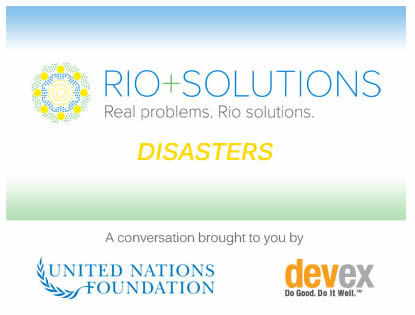 Co-written by Nancy Lindborg, USAID assistant administrator of democracy, conflict and humanitarian affairs and posted on Devex.com on June 4, 2012
Co-written by Nancy Lindborg, USAID assistant administrator of democracy, conflict and humanitarian affairs and posted on Devex.com on June 4, 2012
Over the past year, 13.3 million people in Kenya, Ethiopia, Djibouti and Somalia were thrown into crisis as a result of drought in the Horn of Africa, the worst in 60 years. In response, the United States — together with the international community — spent more than $1.5 billion, saving millions of lives by providing access to food, water and basic health services.
This crisis wasn’t unique. It was merely the peak of a decades-long pattern of emergency and response in the region. Over the last decade, the United States has spent more than $5 billion in humanitarian assistance for countries in the Horn of Africa alone.
But money, time and effort are nothing compared to the suffering and loss that dry-land communities continue to face. Because of a changing climate, droughts are becoming more frequent, hitting vulnerable communities harder, and creating more hunger emergencies than ever before. As a result, families are uprooted, brothers and sisters lose their siblings, and millions of pastoralists struggle to maintain the only existence they have ever known.
It does not have to be this way. Droughts cannot be prevented, but they can be predicted and mitigated thanks to investments in early warning systems, satellite technology and on-the-ground analysis. By identifying those communities facing the gravest risks and strategically focusing our efforts, we can help them withstand crisis.
To provide help that has lasting impact, we must expand our focus from relief to resilience — from responding after emergencies to preparing communities in advance and helping them prevail afterwards. Even as we maintain our enduring commitment to humanitarian assistance, we can use it to achieve long-term results.
At a meeting in Nairobi, Kenya, in April, we committed to do just that by joining with African leaders and our international donor partners to create the Global Alliance for Action for Drought Resilience and Growth. The alliance is working to ensure that resilience programming is a core component of dry-land programs in the Horn of Africa. Serving in the role of secretariat this year, the U.S. Agency for International Development is leading the alliance on a path to meaningful results, with the goal of having a solid progress report in six months.
As we work to make resilience central to our approach through the alliance and other efforts to better integrate our relief and development work, one of the simplest and most important things we can do is to support livestock. Cattle, goats and other animals often represent the only assets that dry-land communities have. By vaccinating livestock, improving herd quality and insuring pastoralists against loss, we can prevent communities from losing their herds every time a drought strikes.
We can also help farmers in these communities conserve water by helping people dig wells and build rain catchments, employ drip irrigation systems rather than relying solely on rain, and developing better seeds that can resist droughts. Our support for local governments to offer safety net programs also helps both pastoralists and farmers cope. Last year, our support of Ethiopian safety net programs helped prevent eight million people from slipping into crisis.
Some might assume that dry-lands and deserts cannot actually provide a sustainable livelihood for millions of people. But livestock cultivation is a large and vibrant source of economic activity in the Horn of Africa, contributing nearly $300 million to regional economies. A thriving livestock trade with the Middle East brings in over 35 percent of agricultural gross domestic product in Kenya and Ethiopia. In many cases, pastoralism is a lifestyle that is sustainable, profitable, and worth protecting.
Health and nutrition are an equally important part of the equation; severe malnutrition is a hallmark sign of chronic underdevelopment that especially endangers children under the age of five. That is why a clear focus on improving nutrition is at the heart of our shift from food aid to food assistance, even as we continue to meet immediate needs.
Most importantly, we have to beat a constant drum: Every time a disaster or a drought or a food crisis imperils millions, we have to remind the world that we must generate the same kind of creativity, resourcefulness and generosity toward long-term solutions that are demonstrated during emergencies.
Today, conditions in the Horn remain tenuous, even as a new drought is driving millions into crisis in the Sahel, the dry-lands stretching from Senegal to Chad. Conditions could worsen dramatically in coming months in a part of the world that suffers from chronic underdevelopment and high childhood malnutrition under even the best of circumstances. Through targeting those most vulnerable, strengthening nutrition and using market-sensitive, cash-based programs that access locally available goods, USAID is working to ensure that our humanitarian response builds the resilience of these communities and countries even as we save lives.
Ultimately, when we talk about resilience, we are talking about dignity. We are talking about helping people stay in their communities instead of being forced to leave in search of help. We are talking about helping farmers and pastoralists improve their livelihoods and grow their incomes, instead of losing their crops or herds. We are talking about local efforts that allow neglected communities the chance to endure during crisis, instead of depending on handouts from foreign donors.
That desire for dignity — relying on yourself instead of depending on others — is something that we all seek. If the international community focuses on resilience — not just relief — then we can do our part to support them.
Tell us what you think! Comment below or tweet to @devex with #RioPlusSolutions, and catch up on other Rio+Solutions content here or on Facebook.



 View All Blog Posts
View All Blog Posts